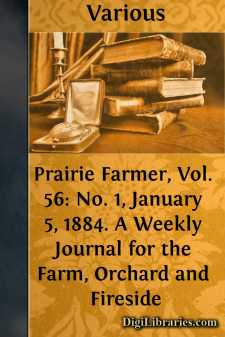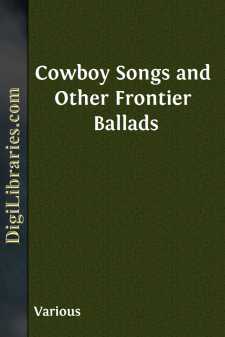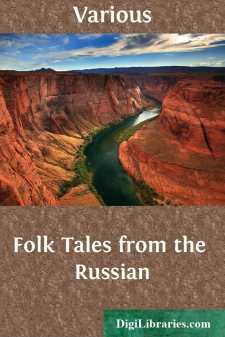Categories
- Antiques & Collectibles 13
- Architecture 36
- Art 48
- Bibles 22
- Biography & Autobiography 813
- Body, Mind & Spirit 138
- Business & Economics 28
- Children's Books 12
- Children's Fiction 9
- Computers 4
- Cooking 94
- Crafts & Hobbies 4
- Drama 346
- Education 46
- Family & Relationships 57
- Fiction 11821
- Games 19
- Gardening 17
- Health & Fitness 34
- History 1377
- House & Home 1
- Humor 147
- Juvenile Fiction 1873
- Juvenile Nonfiction 202
- Language Arts & Disciplines 88
- Law 16
- Literary Collections 686
- Literary Criticism 179
- Mathematics 13
- Medical 41
- Music 40
- Nature 179
- Non-Classifiable 1768
- Performing Arts 7
- Periodicals 1453
- Philosophy 64
- Photography 2
- Poetry 896
- Political Science 203
- Psychology 42
- Reference 154
- Religion 508
- Science 126
- Self-Help 81
- Social Science 81
- Sports & Recreation 34
- Study Aids 3
- Technology & Engineering 59
- Transportation 23
- Travel 463
- True Crime 29
Prairie Farmer, Vol. 56: No. 1, January 5, 1884. A Weekly Journal for the Farm, Orchard and Fireside
by: Various
Categories:
Description:
Excerpt
Prof. John W. Robson, State Botanist of Kansas, sends The Prairie Farmer an extract from his last report, concerning a tame grass for hay and pasturing which is new to that State. The grass has been on trial on an upland farm for two years, during which time he has watched it very closely. The Professor says, "It possesses so many excellent qualities as to place it in the front rank of all cultivated grasses." He enumerates from his notes:
1st. The seed will germinate and grow as easily as common oats. 2d. It maintains a deep green color all seasons of the year. 3d. Its roots descend deeply into the subsoil, enabling this grass to withstand a protracted drouth. 4th. Its early growth in spring makes it equal to rye for pasturage. 5th. In the next year after sowing it is ready to cut for hay, the middle of May—not merely woody stems, but composed in a large measure of a mass of long blades of foliage. The crop of hay can be cut and cured, and stowed away in stack or barn, long before winter wheat harvest begins. 6th. It grows quickly after mowing, giving a denser and more succulent aftermath than any of the present popular tame grasses.
For several years, he says, we have been looking for a grass that would supply good grazing to our cattle and sheep after the native grasses have become dry and tasteless. In the early portion of 1881, his attention was called to a tame grass which had been introduced into the State of Michigan from West Virginia. This forage plant was causing some excitement among the farmers in the neighborhood of Battle Creek. So he entered into a correspondence with a friend living there, and obtained ten pounds of seed for trial. The result has been satisfactory in every respect. The seed was sown April 1, 1881. It germinated quickly, and the young plants grew vigorously. During the whole summer they exhibited a deep-green color, and did not become brown, like blue-grass, orchard grass, or timothy. As soon as the spring of 1882 opened, growth set in rapidly, and continued till the latter end of May, at which period it stood from three to four feet high. At this time it was ready for the mower; but as the production of seed was the object in view, it was not cut till the second week in June. The plot of ground of about half an acre, on which ten pounds of seed were sown, produced three barrels of seed.
He exhibited a little sheaf of this grass at the semi-annual meeting of the Kansas State Horticultural Society, where it excited much attention—the height, softness of the stem, length of blade, and sweet aroma surprised every one present.
On the last day of August, he went into the plot with a sickle, and cut two handfuls of aftermath which measured twenty inches in growth. This he tied to a sheaf of the June cutting, and exhibited the same at the State Fair, where it attracted much attention and comment.
Here, then, we have, he continues, a grass that will insure a "good catch" if the seed is fresh; that can endure severe drouth; that produces an abundant supply of foliage; that is valuable for pasture in early spring, on account of its early and luxuriant growth; that makes a valuable hay; that shoots up quickly after being cut; and affords a fine crop of aftermath for grazing during the late fall and winter months.
The Professor is very anxious that the farmers of Kansas should test this grass during the season of 1883. Still, his advice is not to invest too largely in the experiment....












